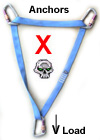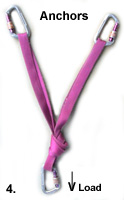Sponsored By
ROCK
HARDWARE
Equalising Anchors
(Chockstone does not take any responsibility for the
accuracy of this article, or it's suitability for the purpose. Use at your
own risk. Chockstone Photography | Landscape Photography Australia | Australian Landscape Photography
Please read the full disclaimer)
Equalising anchors correctly reduces the potential load on each anchor by distributing the weight. This is a very useful tool, making two equalised anchors far superior too two anchors set in series. Two anchors that by themselves may not hold much of a fall, when combined correctly may well be stronger.
However, when equalising anchors you should NOT spread them too far apart or the concept of equalisation will actually work against you rather than for you. The diagram below shows that the reliability of the anchors decreases the wider they are spread apart.
Below: An 80kg load clipped to two equalised anchors. (Source AMGA 1992 manual).
|
40kgs |
40kgs |
43.2kgs |
43.2kgs |
56kgs |
56kgs |
80kgs |
80kgs |
|
|
|||||||
| 50% Load on each anchor | 54% load on each anchor | 70% load on each anchor | 100% load on each anchor | ||||
With the anchors set 160 degrees apart the load on
each anchor jumps to 290% meaning that in the above example of an 80kg
load, each anchor is actually taking a huge 232kgs! Also with widely spread
anchors, slung in the fashion shown above, you are loading the carabiner poorly.
I believe the term is tri-axle loading. As a general rule, try
not to spread your anchors wider than 90 degrees.
Equalising Two Anchors With The Rope
When leading, and equalising anchors at a belay I recommend using a cordelette. If you do use the rope, consider such knots as the In-line Figure Eight, which can be easily elongated to balance the load. Or check out the Bunny Ears. For top roping I suggest a 25m length of static rope (say 11mm), rather than a cordelette, because it will be more durable in the long term.
Right: Two anchors equalised with the rope. The first anchor is tied off with a figure eight on a bite, while the second anchor is clipped to an In-line Figure Eight, whose protruding loop has been easily adjusted to equalise tension of the load between both anchors.
Equalising Two Anchors With A Sling
Further Reading:
Anchor
Principles - From the university of Oregon web site.
Should
I Use The Sliding X - From Dawn's Trad Girl FAQ.
Home
| Guide | Gallery | Tech Tips | Articles | Reviews | Dictionary | Forum | Links | About | Search
Chockstone Photography | Landscape Photography Australia | Australian Landscape Photography
Please read the full disclaimer before using any information contained on these pages.
All text, images and video on this site are copyright. Unauthorised use is strictly prohibited.
No claim is made about the suitability of the information on this site, for any purpose, either stated or implied. By reading the information on this site, you accept full responsibility for it's use, and any consequences of that use.



